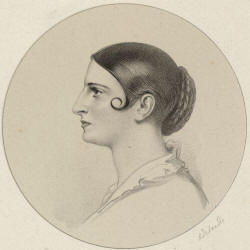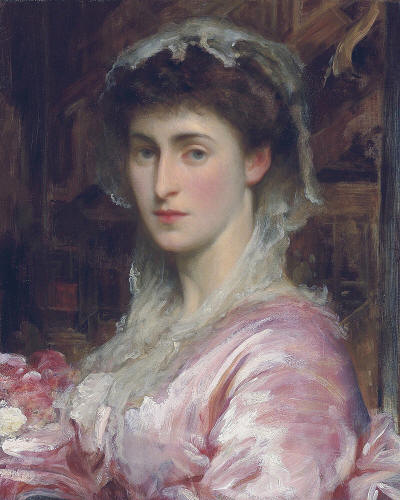

Queer Places:
99 Eaton Pl, London SW1X 8LZ, UK
 Adelaide Kemble (13 February 1815 – 4 August 1879) was an English opera singer of the Victorian era, and a member of the Kemble family of actors. She was the younger sister of
Fanny Kemble, the famous actress and anti-slavery activist. Her father was actor Charles Kemble, her mother Maria Theresa Kemble.
Adelaide Sartoris, who had lived in Rome for two years,
led a salon on Wednesday and Sunday nights in her apartment atop the Spanish
Steps. Trained as an opera singer, she performed regularly at these
cosmopolitan gatherings, which
Harriet Hosmer attended with regularity. Kemble soon
followed her sister to Rome, arriving in January of 1853. Hosmer, enamored
with the city and its community of independent women, wrote that the two
Kemble sisters were “like two mothers to me.”
Charlotte Cushman held her first
reception in her new home in January of 1859, beginning a tradition that would
continue for many years. Mingling at this festive event were the feminist art
historian Anna Jameson, Fanny Kemble, Adelaide Sartoris, and the British
author and reformer Mary Howitt, to name just a few. When the Irish feminist
Frances Power Cobbe came to town, she noted: There was a brightness, freedom
and joyousness among these gifted Americans, which was quite delightful to me.
Cushman had the gift of drawing out the best from all who came, explained
Emma
Crow, the youngest daughter of the philanthropist Wayman Crow.
Adelaide Kemble (13 February 1815 – 4 August 1879) was an English opera singer of the Victorian era, and a member of the Kemble family of actors. She was the younger sister of
Fanny Kemble, the famous actress and anti-slavery activist. Her father was actor Charles Kemble, her mother Maria Theresa Kemble.
Adelaide Sartoris, who had lived in Rome for two years,
led a salon on Wednesday and Sunday nights in her apartment atop the Spanish
Steps. Trained as an opera singer, she performed regularly at these
cosmopolitan gatherings, which
Harriet Hosmer attended with regularity. Kemble soon
followed her sister to Rome, arriving in January of 1853. Hosmer, enamored
with the city and its community of independent women, wrote that the two
Kemble sisters were “like two mothers to me.”
Charlotte Cushman held her first
reception in her new home in January of 1859, beginning a tradition that would
continue for many years. Mingling at this festive event were the feminist art
historian Anna Jameson, Fanny Kemble, Adelaide Sartoris, and the British
author and reformer Mary Howitt, to name just a few. When the Irish feminist
Frances Power Cobbe came to town, she noted: There was a brightness, freedom
and joyousness among these gifted Americans, which was quite delightful to me.
Cushman had the gift of drawing out the best from all who came, explained
Emma
Crow, the youngest daughter of the philanthropist Wayman Crow.

Portrait of her daughter May Sartoris by Frederic Leighton c1870
Adelaide studied in London with John Braham and in Italy under the great soprano Giuditta Pasta. On 2 November 1841, she made her first operatic performance on the London stage in Norma. In 1843 she married Edward John Sartoris and retired after a brief but brilliant career.[1] They were hosts at the Belgravia home to Frédéric Chopin where, in 1849, he made his London debut. This is now marked by a plaque. She wrote A Week in a French Country House (1867), a bright, humorous story, followed by other, more mediocre tales.[2] She recorded one interesting incident at a late London concert by Pasta, whose powers had diminished badly, and she asked of fellow singer Pauline Viardot what she thought of Pasta's voice now and got the reply: "Ah! It is a ruin, but so is Leonardo's Last Supper." Her son, the singer Algernon Charles Frederick Sartoris, married Nellie Grant, the daughter of the famous American general and president Ulysses S. Grant, on 21 May 1874 in the East Room of the White House. Their son, Algernon Edward Sartoris, married the granddaughter of the conductor Sir Charles Hallé, Germaine Cécile Noufflard. The young Frederic Leighton (the painter of Flaming June and a president of the British Royal Academy of Art from 1878 until his death in 1895) was introduced to her circle in Rome, and was greatly influenced by her in many respects, most evidently, perhaps, in social and musical areas. Her soirees surely were an inspiration for his famous, annual "Leighton Musics" later in the great Victorian painter's career, held in his home (now Leighton House and open to the public) in Kensington in London. Mrs. Sartoris and the younger artist, who shortly before his death was granted a peerage, becoming Lord Leighton, maintained a close friendship for the rest of her life.[3] Leighton painted several portraits of her daughter, Mary Theodosia (May) Sartoris, who married Henry Evans-Gordon. Their daughter Margaret Evans-Gordon married Sir Arthur Stanley, 5th Baron Sheffield; their daughter Pamela Stanley (Adelaide's great-granddaughter) was an actress noted for her film and stage portrayals of Queen Victoria.
My published books:
Dabakis, Melissa. A Sisterhood of Sculptors . Penn State University Press. Edizione del Kindle.